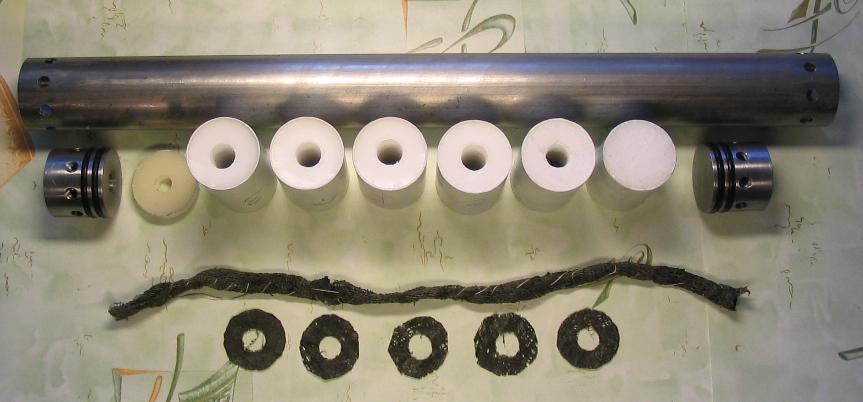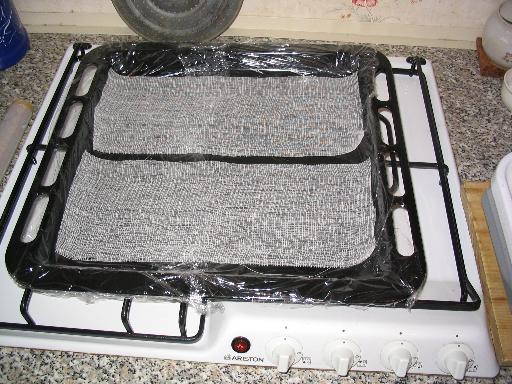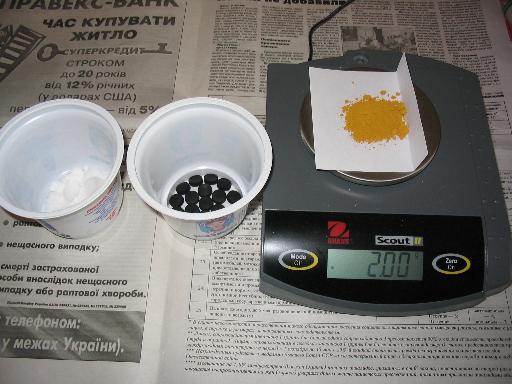
<
Serge77 - My Rocket Workshop >SECONDARY IGNITION COMPOSITION
Rapid ignition of the entire propellant surface is very important condition for effective work of solid rocket motor. If this does not occur, some part of the propellant uselessly burns at a low pressure, thrust grows slowly, and rocket can slip down from launch rail while on the low thrust and fall on the ground.
For the solution of this problem I use a secondary ignition composition (SIC)- medical cotton bandage, impregnated with fastburning mixture. I have used it for the first time in motors SFM1 and SFM2:

Black washers and cord in the foreground are secondary ignition composition. Washers were placed between the grains, and cord was stretched throughout entire core. This ignition system works according to the principle of quick match, i.e., practically instantly transfers fire throughout its entire length; therefore it is not necessary to place igniter as deep in a motor as possible, as in "usual" motor. I place igniter in the nozzle close to the end of the cord. The time of motor activation is about 0.1 seconds.
Comparison of different ignition compositions is described here and here.
SIC MANUFACTURE
SIC-1
Components: KNO3-charcoal-sugar-iron oxide in 75-15-5-5 ratio, about 0.1 g of dry mixture per 1 cm2 of bandage.
Charcoal: I use tablets of medical activated charcoal, it is made from milled charcoal by pressing, they quickly disintegrate when placed in water, so no additional milling is required.
Iron oxide: I have tested yellow, red and brown iron oxides, they all work.
At first it is necessary to prepare bandage, spreading it on a smooth surface, covered with polyethylene.



Drying at room temperature takes 2-3 days. DO NOT dry in the oven!
Thickness of finished product is about 1 mm.
SIC-3
Components: KNO3-Al-S-iron oxide-wallpaper glue(modified starch) 57-30-10-1-2 ratio, about 0.1 g of dry mixture per 1 cm2 of bandage.
Al - paint grade powder
S - colloidal or other dispersed sulfur
Iron oxide - same as for SIC-1.
Wallpaper glue - modified starch. Maybe CMC will be good too.
Procedure: KNO3, iron oxide and sulfur (5.7g, 0.1g, 1g) are thoroughly mixed, then solution of 0.2 g glue in 7 ml water is added, mixed, then 3 g of aluminum is added and mixed up to full uniformity. If mixture is too thick, small amount of water should be added. Resulting mass is spread evenly on bandage with spoon and dried at room temperature. The result is like this:

Thickness of finished product is about 1 mm.
QUALITY CHECK
Strip of SIC 10 mm width should burn at a rate 5-7 mm/s or faster when unconfined. The same two strips, when loosely wrapped in paper, burn practically instantly with a flash
03.06.2005 Serge77